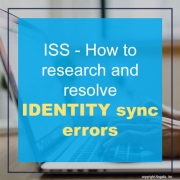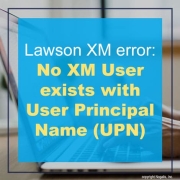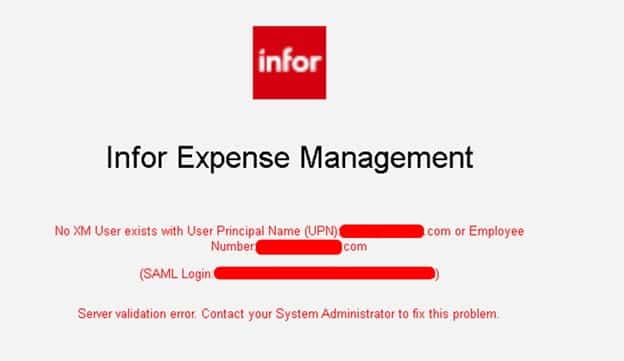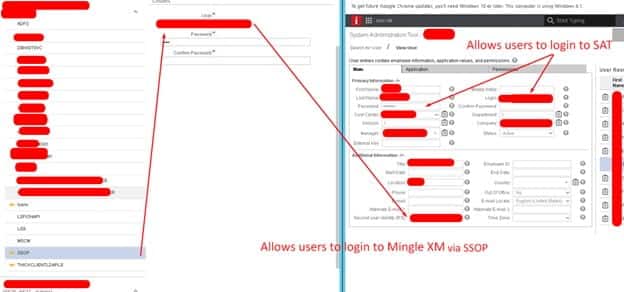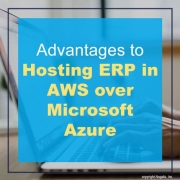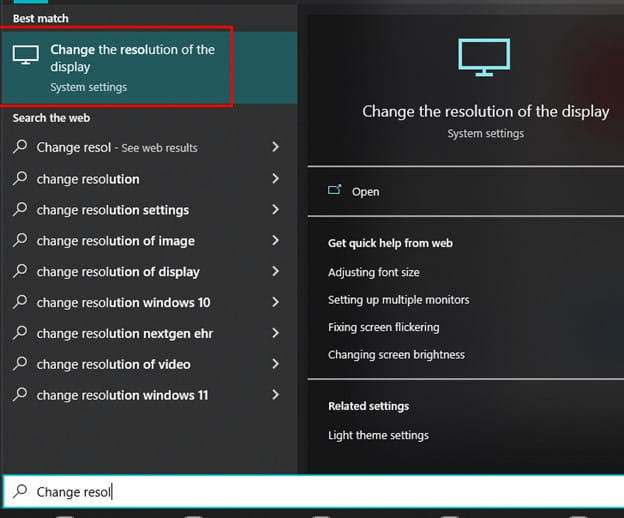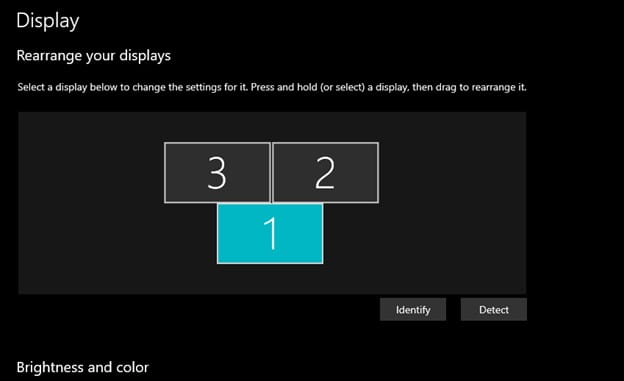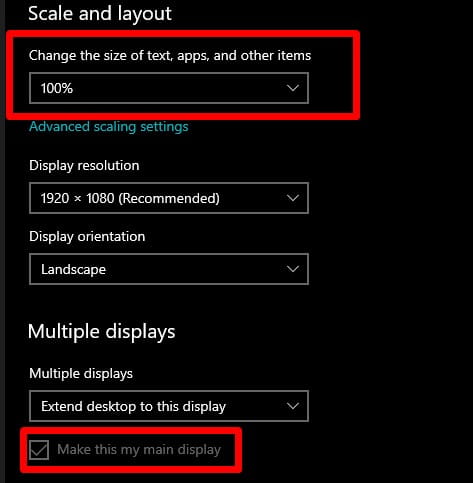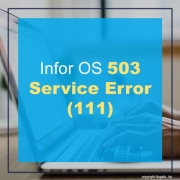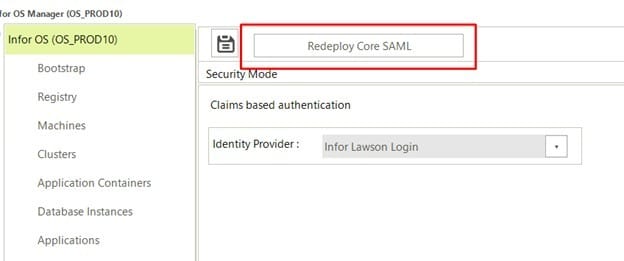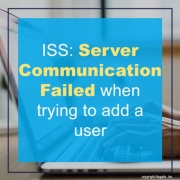For errors related to the failed IDENTITY records from an ISS sync follow these steps:
Determine which system, Lawson System Foundation (LSF) or Landmark (LMK), the identity record failed in:
After finding the exception in the log, scroll up in the log until you see a message such as this:
Getting resource from INFORBCLM01.INFORBC.COM;9906;9907;LANDMARK
or
Getting resource from INFORBCLS01.INFORBC.COM;6626;6627;LSS
or
Processing record #4,996 of LSF
or
Processing record #4,986 of LANDMARK
Messages that reference LSS or LSF indicate the issue is in LSF and the record should be reviewed in that system. Messages that reference LANDMARK indicate the issue is in LMK and the record should be reviewed in that system.
Lawson XM errors are never good, but can easily be resolved. For example, you make come across this Lawson XM error: “No XM User exists with User Principal Name (UPN)” (see screen shot below)
This error can easily be resolved by checking the settings for specific permissions.
In LSF ISS you must make sure that the SSOP identity user matches the Second user Identity (IFS) in XM SAT. These parameters allow users to log in to Mingle XM via SSOP and allows users to log in to SAT. Once you confirm these permission settings, you shouldn’t have the error again.
In today’s digital era, Enterprise Resource Planning (ERP) systems have become crucial for businesses of all sizes. These systems help organizations manage their day-to-day operations efficiently by providing a single source of truth for all data related to finances, inventory, customer relationship management, and more. However, choosing the right cloud provider for hosting an ERP system is critical for the success of your business. In this blog post, we will discuss the advantages of hosting an ERP system in Amazon Web Services (AWS) over Microsoft Azure.
Scalability
AWS is known for its scalable cloud infrastructure, which can support businesses of all sizes. As the demand for an ERP system grows, AWS can easily scale up the infrastructure to accommodate the increased traffic. AWS offers a wide range of resources such as compute, storage, and databases, which can be scaled up or down based on business needs. Microsoft Azure also offers scalability, but AWS’s scalability capabilities are considered superior.
Security
Security is a top concern for any business when it comes to cloud hosting. AWS has a robust security model and offers various security features such as network isolation, encryption at rest and in transit, and identity and access management. AWS also complies with various security standards such as SOC 1/2/3, PCI DSS, and HIPAA. Microsoft Azure also provides robust security features, but AWS’s security features are considered more mature and reliable.
Cost-effective
Cost-effectiveness is a critical factor for any business when it comes to cloud hosting. AWS offers various pricing models, including pay-as-you-go and reserved instances, which can help businesses save money on hosting an ERP system. AWS also offers various cost optimization tools such as AWS Cost Explorer, which can help businesses analyze their spending and optimize their costs. Microsoft Azure also offers cost optimization tools, but AWS’s pricing models are considered more flexible and cost-effective.
Reliability
Reliability is crucial when it comes to hosting an ERP system. AWS has a global infrastructure that spans across various regions, which helps ensure high availability and reliability. AWS also offers various services such as Amazon CloudWatch and Amazon Route 53, which can help businesses monitor the availability and performance of their ERP system. Microsoft Azure also offers high availability and reliability, but AWS’s global infrastructure is considered more reliable.
Conclusion
In conclusion, hosting an ERP system in AWS offers several advantages over Microsoft Azure. AWS offers scalability, robust security features, cost-effectiveness, and reliability. While Microsoft Azure also offers these features, AWS’s capabilities are considered superior. Therefore, businesses looking to host an ERP system in the cloud should consider AWS as their preferred cloud provider.
If your Lawson Addins or Macro Workbook buttons stopped working all of a sudden in Excel then this guide is for you.
First let’s make sure this issue is only occurring to your PC. If this is a wide spread issue among all users, it’s likely a Lawson Addins or Excel version issue. I would refer to the addins compatibility matrix provided by Infor.
If this is only occurring to a specific user. Then it’s likely a display issue, follow the steps below.
- Go to start and type “Change Resolution of the display” and select that option:
- Click on the monitor that is set as your “Main display”
- Scroll down under Scale and Layout and set the size of Text, App etc. to 100%
- Once your main display is set to 100%, your Re-open your Excel Lawson Macro Workbook and see if the button is functioning correctly.
- IMPORTANT: If another external monitor scale and layout settings are above 100%, it will also break the excel workbook spreadsheet when the application is being viewed from that monitor (so it dynamically changes when you move apps between monitors).
If you receive a 503 Service Error (111) after an Infor OS install or update, it is possible that the SAML configuration was not properly deployed. Another symptom of this issue is if the Grid-XiPlatform application doesn’t show up under Applications in the InforOSManager.
To resolve this issue, try to redeploy the Core SAML. Log into the InforOSManager and click on the main Infor OS instance. Click the button “Redeploy Core SAML”. Once it is successfully deployed, click the Save button. Then, reboot the server.
To validate, make sure that the Grid-XiPlatiform application is available in InforOSManager. Now, the grid home page should load.
Problem:
You may come across this issue in Infor Security Services (ISS): “Server communication failed when trying to add a user.” This usually means that ISS did not respond to your command. Any attempts to add a user yield the following error message: “Server Communication Failed.”
Resolution:
There is a simple solution to this command error. Since it is seemingly a minor technical error, all you need to do is Reboot the LMK server. This will re-establish the connection between Lawson System Foundation (LSF) and LMK. The ISS should respond to your command now and you can proceed to add a new user.


